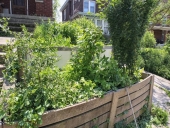posted 7 years ago
We have about 60 fruit trees on our 1/3rd acre, with all the other space in between planted with annuals, veggies, root crops and such. Additionally, we've got 8 chickens that lay eggs.
With all that, there is no way we are even close to being self-sufficient. We harvest about 30 to 50% of our calories from our food forest, a much higher percentage in the warm summer months than in the winter, but it wouldn't be enough for us to survive on unless I found a way to significantly ramp up production. As things stand, I buy my chicken feed, we buy most of our protean (meat, fish) and all our dairy, we spend upwards of $500 a month at Costco. Could we eat a simpler diet, much lower down the food chain? Of course we could, and if times got desperate, we'd be forced to do so. But even if I planted out every last square inch of our property with food-bearing plants, I don't think we'd be able to survive on that alone.
If I can humbly question the premise of the OP, there are a couple of things I've found that have changed my perception of how we live.
1. My goal isn't total self-sufficiency. It's quality of life, quality of food, nutrient density, and living well. Thus, my energy is given to quality, not shear quantity.
2. The whole idea of growing a food forest for the possibility of a "shit hits the fan" scenario is energy dedicated to the negative, not the positive. I've been around preppers and end-of-days doomsday types for over 30 years. I spent a summer with one way back in 1983, and he was all over me trying to get me to drop out of college to prepare for the "inevitable" collapse of the monetary system. He died a poor and miserable man 2 decades later, while I went on to not only finish my eduction, but to put that eduction to good use. It would appear to me that fear, while powerful, is ultimately a poor motivator to sustain a life well-lived. Love is a much greater and life-giving motivation. Fear of the collapse of society, fear of peak-oil, fear of zombies, fear of jack-booted government forces . . . honestly, I just can't find myself getting motivated to go out and plant a big garden if these are the boogie men that I'm supposed to prepare myself to stand against.
Grow what you love and share that with those you love! Reacting against what you fear is a zero-sum proposition. I transitioned from asking the question, "How many calories can I realistically expect from this avocado tree if we needed it to survive?", to asking, "When are the kids coming home?, because I need to pick avocados 2 weeks in advance of that—they love my gaucamole!" Even my chickens are kept as much because I love to see them out there scratching and pooping and enjoying their chickeness. I don't keep them because of a "what-if" scenario, but because they give me joy.
3. If the SHTF, those that survive will be those who have social capital just as much as physical/food growing capital. Thus, I cultivate meaningful community with friends, family and neighbors. At least a third of what I grow gets shared with others. How many peaches can you realistically eat in those 2 weeks when they all ripen at once? So why not turn excess peaches into good will and meaningful, life-giving relationships? My wife likes to joke that our avocado, pomegranate, lime and apple trees grow pork: we give our Hispanic neighbors fruit and the return with tamales, carnites and posole. Cultivate neighbors, not just trees.
Sermon over.
I'd plant grafted trees suitable to your area.
I'd plant nut trees, as they provide a great deal of calories that can be stored. Off our one almond tree, we harvest about 40 lbs. of nuts a year.
I'd plant an understory of easily maintained root crops. Sweet potatoes are our go-to crop in this regard: we ignore then and they come up year after year, volunteer.
I'd plant a lovely teak bench somewhere back in a shady corner where you can sit quietly with someone you love and enjoy the beauty of all that you are growing.
"The rule of no realm is mine. But all worthy things that are in peril as the world now stands, these are my care. And for my part, I shall not wholly fail in my task if anything that passes through this night can still grow fairer or bear fruit and flower again in days to come. For I too am a steward. Did you not know?" Gandolf

 1
1




 3
3












 1
1


















 2
2




 1
1









